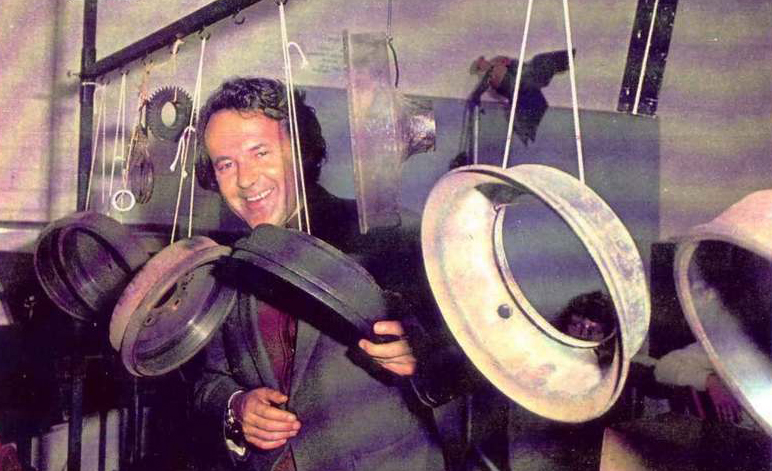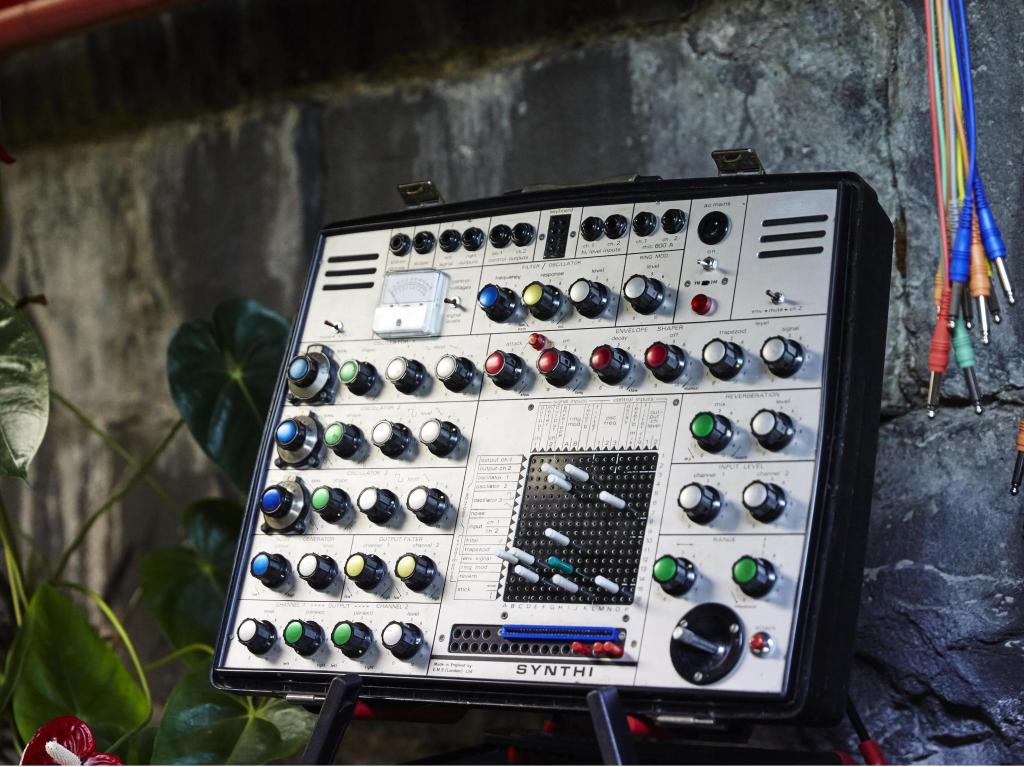Synthi AKS. Image credit: Kristoffer Paulsen
When Australian composer Keith Humble returned from Paris to Melbourne in the late 1960s, he brought with him ideas, enthusiasm and a personal collection of rare synthesizers, which he used to create a renegade electronic experimentation studio at the Grainger Museum from 1969-1974 for students and composers.
Synthesizers: Sound of the Future revisits this period in the museum’s history by bringing together for the first time, the suite of early Electronic Music Studios instruments (EMS) on loan from Melbourne Electronic Sound Studio (MESS). These included the rare VCS1 synthesizer, the VCS3 and the Synthi 100. In addition to these instruments, a selection of scores, videos and music re-composed from that period are on display.
It was while flicking through the Grainger’s archives that exhibition curator Heather Gaunt made a discovery that culminated in the creation of the exhibition. It was a video from 1976 produced by the ABC, featuring tonmeister Les Craythorn who was programming Percy Grainger’s music into the iconic Synthi 100 – a rare analogue synthesizer renowned for the ethereal sounds used in Doctor Who.
‘This was my first understanding that the Grainger had this period in its history of being an electronic music studio,’ she said. ‘So I was immediately curious and thinking that it was part of our story which hadn’t been told before.
‘I think really it was forgotten because that period of the Grainger was a very sleepy time. It’s not like it was open as it is now to the public very much. It wasn’t until the late 70s and the 80s that it really started to get more of a public identity as a museum that people could visit.’
It also took considerable time for the work of Humble and his contemporaries to be recognised, said MESS co-founder Byron Scullin.
‘The seeds which were laid down by people like Keith are still bearing fruit today but this is only due to the continued work of a small and passionate group of individuals. For that small group however, they strived in relative obscurity for maybe 10 or 20 years,’ Scullin said.
‘I think it wasn’t until the 90s when many more young people connected with the possibility of electronic music via popular and dance music that they began to look into the recent past to find the groundbreaking work that was done in the 25 years after the war. I think this was probably the generation that looked at an EMS synthesizer the way its inventors did.’

Keith Humble at the Grainger with improvisational instruments (1970s) Image credit: John Whiteoak
A radical thinker
When Keith Humble first took up a post at the Melbourne Conservatorium in the late ’60s, the university wasn’t aware of his passion for analogue synthesis.
‘They didn’t know they were bringing in an electronic music expert,’ Gaunt said. ‘They thought they were just bringing in an ex-student who was brilliant and who had international experience.
‘There were pockets of fascination and interest in early electronic music in Melbourne but he really engineered this hothouse of activity here.’
For Humble, who had spent considerable time overseas immersing himself in experimental music, returning to more of a conventional setting, such as a university, was often a struggle.
‘He brought over a colleague from Paris because he had been there for ten years before he came back to Melbourne and he had developed a very European mindset,’ Gaunt said. ‘He was right in the thick of experimental improvisation; a combination of theatre and sound, completely non-traditional in every possible way. He felt that he was a radical and wanted to feel that he was a radical right until his last day – it was central to his thinking. And I think he felt a little… It was tough being a radical at Melbourne Uni in those days.’
Eventually Humble was offered a position at La Trobe University, which marked the end of his time at the Grainger.
‘La Trobe gave him the opportunity to take that philosophy into a new environment and what happened was, without Keith’s drive and passion, I guess it changed,’ Gaunt said. ‘It didn’t disappear completely, but they took the instruments out of the Grainger within a year because then the ethos shifted again to be the more traditional Grainger archive, so they didn’t see any point of having the synthesizers here because they’d gotten a grant and bought more instruments, which is why Keith was able to take his own instruments away.’
Scullin said the value of these instruments wasn’t recognised by Melbourne Uni at the time.
‘By the time I made my way to the university in the early ’90s there was no sign of electronic music aside from its use as a tool adjunct to traditional music; the Synthi 100 sat dormant and unused in a small studio and, due to years of neglect, wasn’t functional so couldn’t be used. It took the university until recently to realise what a special instrument this is and have it restored back to working order.’
A space for experimentation
The current exhibition runs in two modes, an exhibition display and an “open studio” and has ‘reinvigorated the Grainger in terms of a new audience,’ Gaunt said. ‘And I’ve really seen it in terms of the demographic that has come. We haven’t alienated any of our traditional visitors but we’ve definitely been getting younger age groups; hipsters and anything in between.
‘The ethos behind the EMS instruments, particulary pre-keyboards, it was all about noise,’ she said. It was this utopian concept of anybody being able to come and create new sounds instead of having to stick with an existing palette or an existing timbered scale.’
It’s also the first time the entire progress of EMS’s electronic music instruments have been laid out in one place, Scullin said.
‘From Tristram Carey’s home made machines, through rarities like the VCS-1 and the EMS video synthesizer the Spectre. It also tells a lot of the important stories around experimental and electronic music culture in Melbourne. These stories show how Melbourne and Australia are not some backwater of culture, but have had some influence on electronic sound culture globally.’





